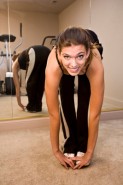You’ve got only one back, and as a nurse, you must protect it.
To safeguard that precious asset, I’ve designed a three step program to help you avoid back injury. Follow these steps from the Spring 2010 issue of Scrubs and you’ll have a significantly easier time protecting your back throughout your nursing career.
Step 1? Stretch. Step 2? Strengthen. Step 3? Stand Tall.
There’s nothing fancy here. No gymnastics or yoga master moves. And most of it can be done right at work.
And yes, you need to incorporate all three. While flexibility, strengthening and posture are separate and can be highly complicated, each factor is codependent on the others. If you or your back becomes deficient in one area, the other two will have to compensate and/or will suffer. A weak and/or inflexible back will lead to posture problems. An inflexible back causes muscular imbalance and inflexibility. The circle is never-ending. The take-home message is that all three areas need to be healthy, not just one.
Because…who’s got your back? I mean literally. Who’s taking care of your back?!
So first, 5 stretches you can do at work and at home.
Next, 3 strengthening exercises.
Finally, 4 tips for standing tall.
Ready to begin? Let’s stretch.
So…flexibility. This is a toughie. Most people think their back hurts due to weakness when it’s usually due to inflexibility—but not the inflexibility of your back. Yes, you read that right. Most back problems stem from an inflexible set of hamstrings (also quadriceps and hip girdle complex). Imagine placing a plumb-bob from the tips of your shoulders to your heels. Your back should maintain as straight a line as possible. So flexibility to maintain the health of your back should focus mostly on your hamstrings (which will indirectly help your lower back). But here’s the rub: Stretching your hamstrings is not the same thing as stretching your lower back.
I’ll keep it simple and straightforward.
Stretching (in General)
- Be sure to go slowly and gradually. Don’t expect to extend as far as your body will go. Increasing your flexibility is done in baby steps and over an extended period of time.
- There is good pain and bad pain when stretching. Good pain is that pulling sensation you feel just before the point of that sharp, needle-like, stabbing jolt you get when you push (stretch) further. Be sure to stretch to the point just before the “bad pain.”
- There is no bouncing in stretching! I’ll say that again: Do. Not. Bounce. Bouncing will actually decrease your flexibility and may even cause damage to your ligaments, muscles and tendons.
- Make every attempt to stretch after you get moving. Don’t try and stretch “cold,” as it’s sometimes described. A warm muscle is a safe muscle. Stretching cold can actually tear your muscle if you’re not careful (I’m not making that up!).
- Your goal is to stretch and hold the position for 20 to 30 seconds. Make an attempt at doing this 2 to 3 times, each time trying to stretch a little further.
At Work
1. Standing toe-touches
This will mostly stretch your lower back, but will also awaken your upper hamstrings and gluteus muscles. Stand with feet shoulder width apart and gradually lower your upper body to attempt touching your toes. Be sure to keep your upper back straight, not rounded. Envision bringing your upper chest to your kneecaps. Also be sure to have your knees straight, not bent, while performing this movement.
You can also modify this stretch by crossing your feet in an X shape to help stretch the muscles and tendons along the sides of your legs. Cross your legs in one direction, then cross them the other direction, exchanging which leg is in the front of the X.
2. Seated chest-to-knee
This stretch is simply a modified version of the toe-touches, but it isolates your lower back. Sit in a stationary chair with your feet flat on the floor and your thighs as close to perpendicular to the floor as possible. Gradually bring your chest to your lap (kneecaps), maintaining a straight upper back, not rounding or curving your upper back.
3. Side lunge lean
While standing with your feet shoulder width apart, bring both your arms above your head. Now with your arms above your head, lean your whole upper body (torso) to the left. Leaning to the left will stretch the opposite side of your torso. Repeat in the other direction. This feels great before, during and after a long shift. This will obviously loosen up those sides while indirectly loosening up your lower back.
4. Wall twist
Standing with your back against a stationary wall, turn your upper body (torso), taking your left hand and reaching it across to touch the wall behind your right shoulder. Repeat with your right hand reaching across to touch the wall behind your left shoulder. This is great for stretching all the intrinsic stabilizing and rotator muscles. It’s also another great way to loosen up your lower back.
At Home
5. Seated toe-touches
This is the standing toe-touch from a seated position. While sitting on the floor, legs together and feet together, you do the same movement as before. Lower your upper back to your thighs (kneecaps) while maintaining a straight upper back. Conventional wisdom would lead you to believe this also stretches your lower back, but it actually isolates your hamstrings. It will stretch your upper and lower hamstrings depending on how far you can lower your torso to your knees. Your knees should be straight during this whole movement as well.
This is a very brief list of basic exercises to awaken and loosen your back and hamstrings; there are just too many stretches out there to name and list them all. In the end, it’s about the safety and health of your back—you only get one of them!
Now, time for strengthening.



















